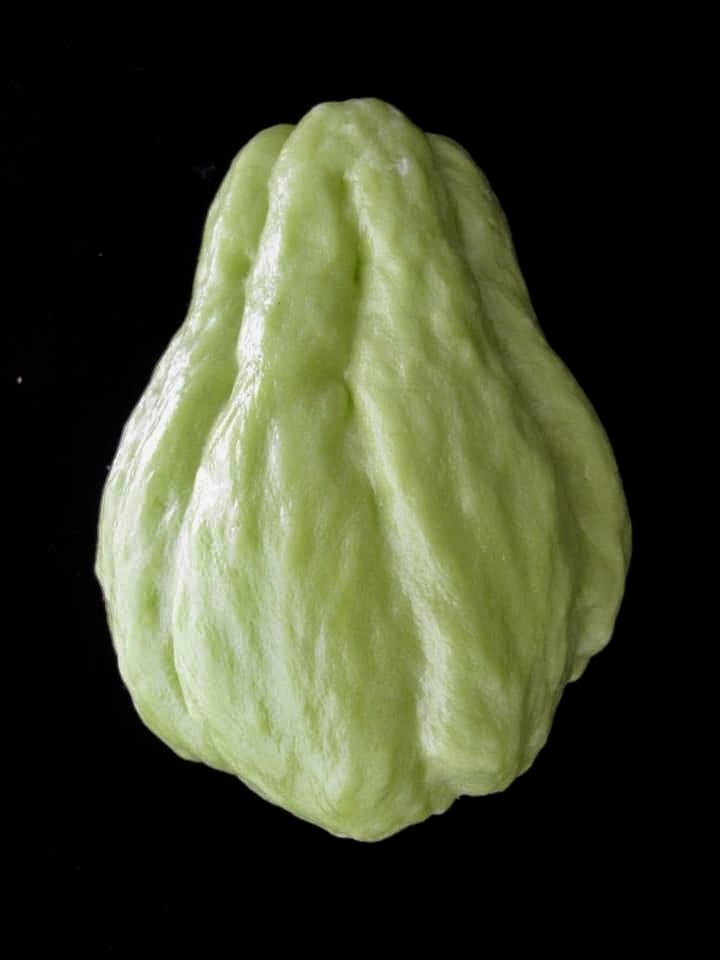
Up until about 2020, any mirliton grown in Louisiana was an heirloom mirliton. They were what botanists call a “landrace.” Landraces are domesticated plants that developed over time and adapted to their natural environment and are not the product of human manipulation–such as plant breeding or modern genetic science. Haitians brought the first mirlitons to Louisiana over two centuries ago and that landrace thrived because it was adapted to our altitude, climate, pests, and diseases.
The mirliton landrace is easy to recognize because of its distinctive fruit traits; they are large, slightly pear or egg-shaped, with smooth skin, longitudinal furrows (though a few may be unfurrowed), and either green or white. Over the years other varieties were introduced from Mexico and Central America and interbred with the Louisana landrace. The resulting landrace was what generations of Lousianians simply called “mirlitons.” And for most of the last two centuries, there was only one variety.
Then things changed. After Hurricane Katrina wiped out almost all mirlitons in New Orleans, garden experts advised me to buy any chayote (mirliton) from a grocery store and plant it. That didn’t work because almost all imported chayote grew at high altitudes and would not produce in Louisiana. So I began to search for growers of our Louisiana landrace to replace the New Orleans ones. I soon found many growers in rural areas and when I did, I would name the mirliton after the grower so that we could track and preserve it.
I eventually noticed differences within Louisana mirlitons–there were clearly different subvarieties in the landrace. Mirlitons were more complex than we thought. Since the Louisiana mirliton has never been genetically analyzed, I decided to classify the subvarieties by fruit appearance (morphology), and then interview the growers to determine the strain’s history. If I could establish that the mirliton had been continuously grown for at least two decades, then I named it after the grower. That way we could keep that particular line going. That’s how named varieties came to be.
So there are two categories of Louisiana mirlitons:
1. Unnamed Louisiana Mirlitons is the name for the traditional Louisiana landrace. That encompasses almost any mirliton that was locally grown in Louisiana. We call these “unnamed variety.”
2. Named Certified Louisiana Mirlitons are the few strains within the larger unnamed category that Mirliton.Org has named after investigating and verifying they have been continuously grown for at least twenty years in Louisana. There are currently twelve named certified varieties of Louisiana heirloom mirlitons:
Ervin Crawford
Joseph Boudreaux
Ishreal Thibodeaux
Boudreaux-Robert
Blacklege
Papa Sylvest
Bogalusa whites
Chauvin-Rister
Remondet-Perque
Miss Clara
Bebe Leblanc
Maurin
Only these named certified varieties have been researched and verified as authentic heirlooms. If you grow one of these named varieties, you can be confident you are growing a Louisiana heirloom.
Why is it important to continue tracking heirlooms? Beginning in 2020, several grocery store chains began to import chayote (mirlitons) that looked exactly like our heirloom varieties because they sold better. And some people began to grow them because they were indistinguishable from our heirloom variety. The problem is that imported chayote may carry a deadly seed-transmissible virus that can destroy the Louisiana variety. It’s called Chayote Mosaic Virus (ChMV), and it’s devastated crops in other countries.
If you want to preserve the Louisiana heirloom variety and keep them safe, the best way is to only use certified heirloom seeds like the ones named above. Mirliton.Org offers a free certification service and maintains a list of certified growers.
We can also certify new varieties that you may come across–and we expect the list of verified ones to grow. If you find a grower who says that their mirlitons were locally grown but have no name, the grower can ask Mirliton.Org to verify and certify them as an heirloom variety. We will do that by examining fruit characteristics, taking an oral history, and conducting visits to grow sites.